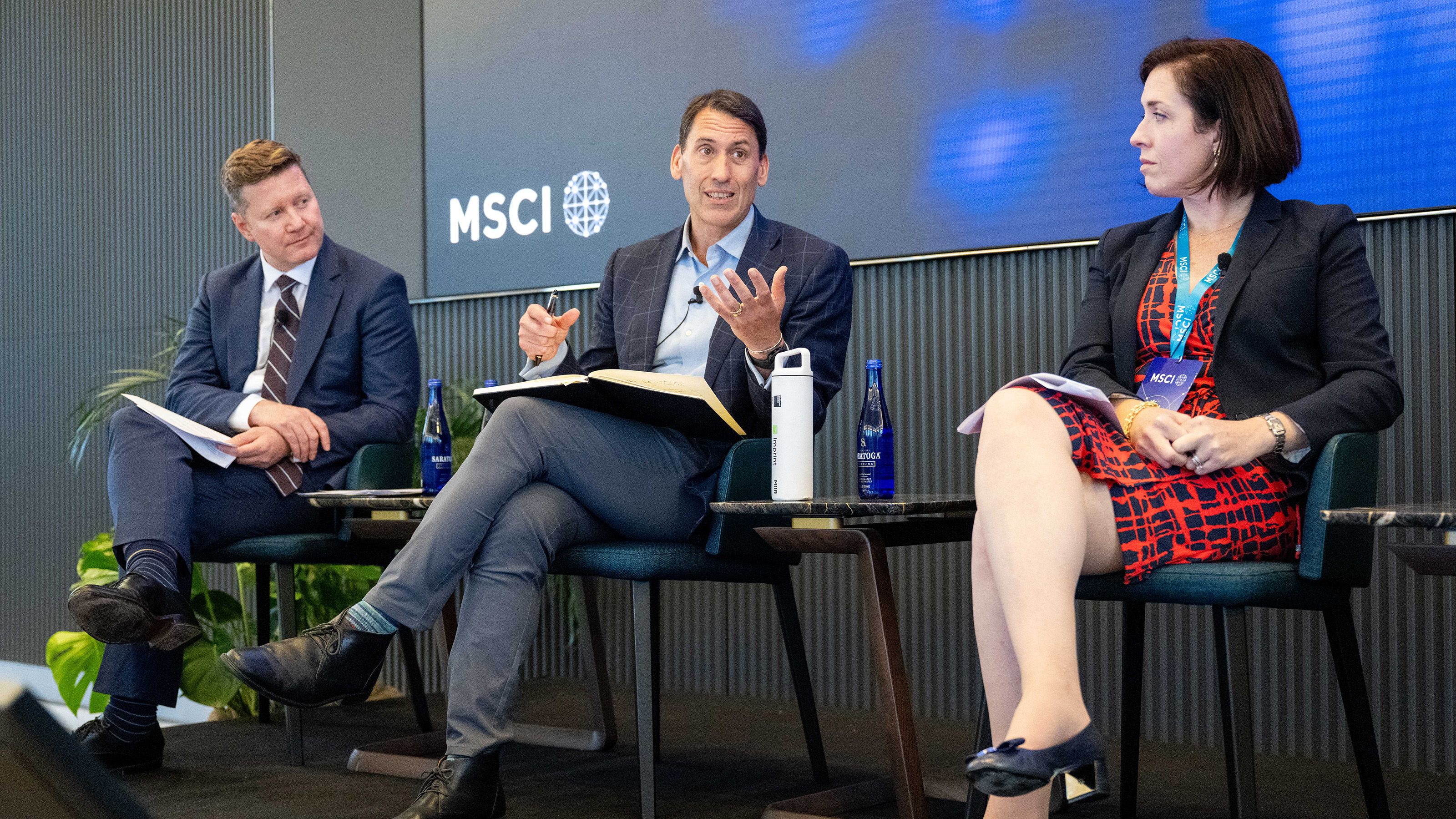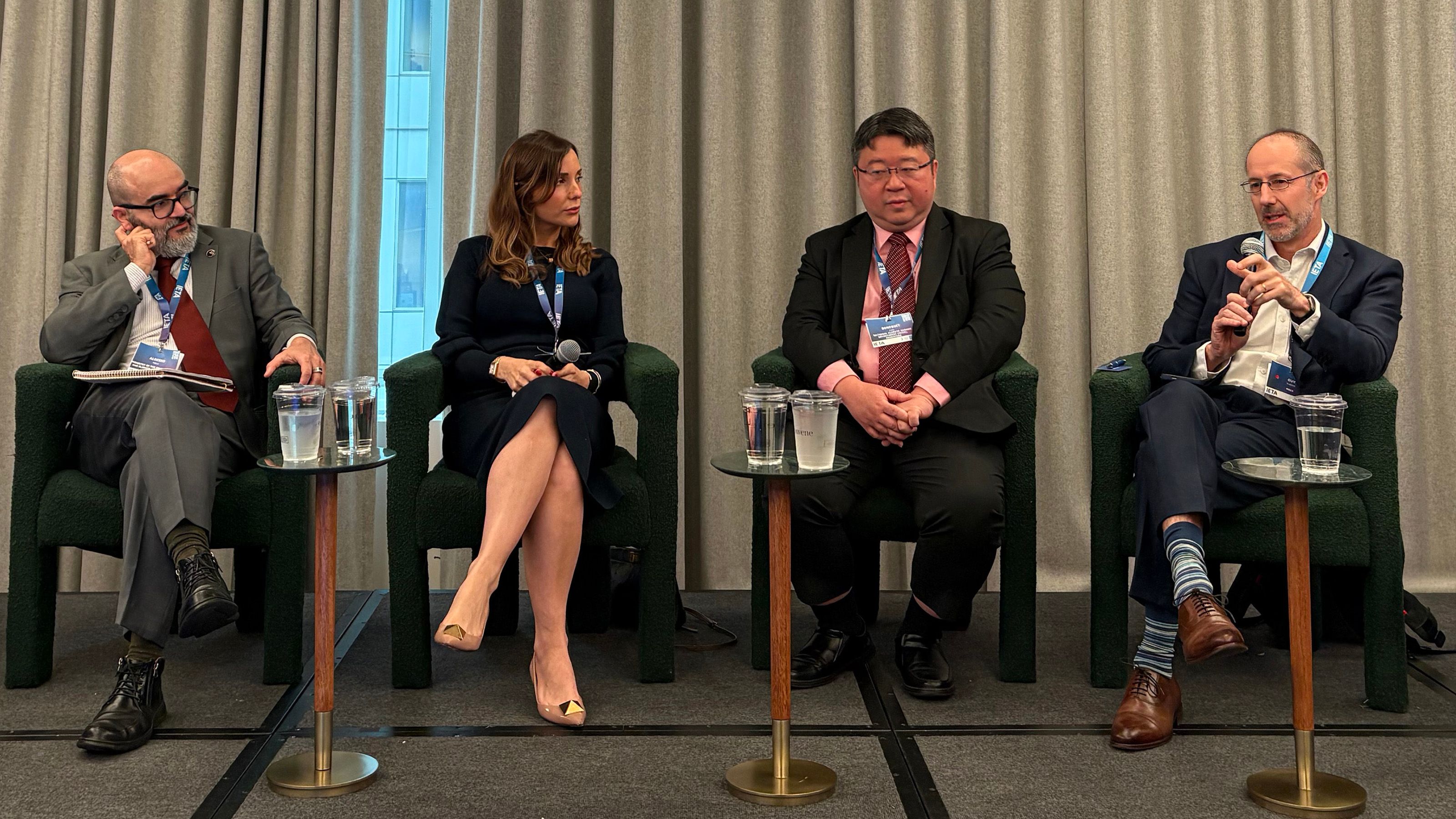Five Takeaways for Investors from Climate Week NYC 2025
- Capital is driving (or chasing?) the transition: Markets are stepping in, differentiating winners and losers as the shift from fossil fuels to renewables gains ground where the economics already work.
- Physical risk is here now: Extreme weather is already costing companies billions, pushing investors to apply geospatial analytics and assess exposures at the asset level before risks cascade into systemic shocks.
- Carbon markets are maturing: International trading frameworks are emerging, with integrity and cooperation key to unlocking private capital — and likely to dominate discussions heading into COP30.
New York Climate Week was larger than ever, with over 1,000 events alongside the United Nations General Assembly, despite taking place against a shifting policy backdrop, including last summer’s repeal by the U.S. of tax credits for investment in clean energy.1
Leaders from MSCI joined peers across finance, business and policy to focus on what matters most for investors: navigating severe weather events, financing the energy transition and unlocking carbon markets to scale private-capital flows. Here are five takeaways.
The influence of market forces and the essential role of capital in the low-carbon transition featured heavily among the conversations. Government action driving climate progress has slowed as policymakers shift their attention to other crises.
- Opening the MSCI’s Americas Summit, Henry Fernandez, MSCI’s chairman and CEO, pointed to a handoff from the public to the private sector, fueled by the economic impacts of climate change and the opportunities of the energy transition. “The transformation from an economy powered by fossil fuels to a growing economy powered by renewable energy will lead to many winners and many losers, and they’re in your portfolio today,” he noted. “The question is how people are going to differentiate among them.”
- Major investors echoed the message. “We are long-term investors,” said Ed Berman, head of public markets and portfolio construction at the New York City Comptroller’s office. “If something is good for society, it’s also good for financial returns. Climate is definitely a big thing in our minds.”
- Peter Cashion, managing director for sustainable investments at the California Public Employees' Retirement System (CalPERS), described the transition as a megatrend alongside artificial intelligence and deglobalization, noting: “We see strong parallels with the technology revolution 30 years ago.”
More than any prior Climate Week, the immediacy of physical risk was front and center. MSCI estimates that chronic and acute physical risks such as extreme heat and flooding could cost the largest listed companies globally USD 1.3 trillion over the next year through asset damage and lost revenues.
- The calculus has flipped: “Two years ago, transition risk was a near-term thing to examine and physical risk was a 2050 thing,” noted Richard Mattison, MSCI’s head of sustainability and climate. “Today that’s the reverse; physical risk hits companies in the here and now, it’s amplifying and the models are lagging. Getting to grips with how we can overlay on every portfolio the physical effects of climate change will be a critical theme for the next five years.”
- Investors echoed the urgency. “Future problems are increasingly reflected in both the present and the bottom line,” said the head of climate advisory at a large financial institution, explaining that the science is now starting to reflect change in the climate that has already happened.2

Left to right, Richard Mattison, MSCI's head of sustainability and climate; John Goldstein, head of sustainability at Goldman Sachs Asset and Wealth Management; and Jamie Franco, global head of sustainable investment at TCW, discuss the geography of physical risk, at MSCI's Americas Summit.
- “We assume physical climate risk is in your portfolio already and that it’s mispriced,” said Jamie Franco, global head of sustainable investment at TCW, noting evidence of physical risk hitting mortgage portfolios as homeowners in hard-hit regions prepay mortgages to buffer rising insurance costs.
- John Goldstein, head of sustainability at Goldman Sachs Asset and Wealth Management, added: “Physical risk is on the menu in a way it hasn’t been until recently. People can see it in their news feeds and portfolios. The pathway in the near term for physical risk is more clear and more certain than for the transition.”
- Physical risk is driving demand for solutions that can help governments, businesses and consumers withstand the impacts of a warming world. “I love finding companies where the management team is open to hearing that they may be an adaptation company,” said Chris Goolgasian, director of climate research at Wellington Management, at a conversation on applying resilience to public markets moderated by Linda-Eling Lee, head of the MSCI Institute.

Linda-Eling Lee, founding director of the MSCI Institute, far left, moderates a Climate Week NYC conversation on applying resilience to public markets with, left to right, Sara Mahaffy, head of global sustainable strategy research, RBC Capital Markets; Chris Goolgasian, director of climate research, Wellington Management; and Shahbano Soomro, deputy head of policy and advisory, Impax Asset Management.
The rise in physical risk is spurring investors, lenders and insurers to analyze companies’ facilities, suppliers and dependencies in increasingly fine geographic scales, making geospatial analytics a strategic necessity.
- “Our aim is to analyze every asset that an investor or a bank might be exposed to and map those exposures to different types of risk and across different locations, whether physical risk, tariffs or nature-related risks,” Richard Mattison explained.
- “All flooding is local,” said Dr. Natalie Lord, principal climate scientist at Fathom. “We are seeing regions being affected by events not seen in a historical period.”
- Jackie Daitchman, a sustainability and climate solutions specialist at MSCI, highlighted extreme heat across Latin America, with wildfire risk in Mexico and Guatemala and water stress in Peru and Venezuela posing growing threats.
For investors, the bigger concern is when local risks cascade into systemic ones.
- “What happens if 10, 20 or 40% of the companies you invest in become uninsurable?” asked Richard Mattison. “It’s not just a California and Florida problem,” agreed TCW’s Jamie Franco, citing insurers pulling out of Iowa and Colorado. “They can’t pull out of every jurisdiction everywhere, so you have to follow that chain of risk,” she observed.
The energy transition has moved well past rhetoric, as renewables accounted for 93% of new electricity generated globally last year.3 Investors are increasingly focused on where money is made and lost as fossil fuels give way to renewable energy and electrification.
- “This competition is settled,” said Tom Steyer, co-executive chair of Galvanize Climate Solutions. “Fossil fuels are the legacy technology. Electrification is today’s dominant theme.”
- “There’s been a real reality check around investing,” noted a consultant, citing a continuous emphasis on value creation and “a lot of technology already in the money.”
- Private capital is flowing where the economics work. Apollo has poured billions into grid modernization and has invested in energy-efficient cooling for data centers.4 “Trillions of dollars are needed to keep growing and stabilizing the grid as we add more renewables,” said Christine Hommes, a partner in private equity at Apollo. “The market for climate will continue to mature and evolve, so our opportunity set will keep moving.”
- Others see opportunity in the disruption itself. The head of sustainable investment research at one large asset manager called the convergence of the energy transition, artificial intelligence and geopolitical fragmentation “an alpha-rich environment.” “We don’t think the low-carbon transition is fully priced in, whether on the upside or downside.”
- Risks and opportunities vary by country, sector and technology. “In power, renewables are now cheap enough that fossil-only generation presents a risk,” noted Mathew Lee, an energy transition specialist at MSCI. “In aviation, however, conventional fuels remain far cheaper than low-carbon alternatives.”
- “This is a multilayered, multifaceted transition,” echoed a Canadian asset manager, citing Southeast Asia’s use of blended finance to accelerate the managed phaseout of coal-fired power.

Guy Turner, head of MSCI Carbon Markets, right, discussing global carbon markets at the IETA’s North America Climate Summit 2025, with, from left, Aloísio Melo, director of mitigation and implementation instruments, Brazil’s Ministry of Environment and Climate Change; Hannah Hauman, global head of carbon trading, Trafigura; and Benedict Chia, director general, Singapore’s National Climate Change Secretariat.
International carbon trading is beginning to take shape, promising lower costs for decarbonization and more efficient capital allocation toward the energy transition and climate adaptation. Modeling by MSCI shows that half of the demand for carbon credits by 2040 will have some regulatory underpinning — from government transfers under Article 6 to aviation and corporate-level trading schemes, noted Guy Turner, MSCI’s head of carbon markets, at a summit hosted by the International Emissions Trading Association (IETA).
For an international market to reach its potential, however, countries will need to develop standardized rules that ease trading and encourage cooperation.
- “You need cooperation to achieve a global system,” Heike Henn, director general for international climate action at Germany’s Federal Ministry for the Environment, noted at the IETA summit.
- “Carbon markets turn on cooperation,” agreed Benedict Chia, director general in Singapore’s National Climate Change Secretariat. “Different companies and countries cooperate to unlock abatement that would not happen otherwise and to crowd in financing.”
The integrity of Article 6 credits will turn not only on the quality of carbon projects but also the host country’s climate ambition, governance and transparent use of corresponding adjustments (CAs), which are intended to ensure that reductions are only counted once.
- “The Article 6 mechanism was structured initially as a watertight system, like a global cap-and-trade system, but in practice it’s more like a sieve,” Guy Turner observed, noting the variability in countries’ nationally determined contributions (NDCs) and that countries can issue CAs with impunity.
- “That’s why we rate the integrity of countries’ NDCs in terms of ambition and delivery,” he explained, referring to MSCI’s Article 6 Integrity Framework, which addresses both country- and project-level risk. “We hope our analysis will drive convergence toward tight and ambitious NDCs, rather than a race to the bottom.”
Subscribe todayto have insights delivered to your inbox.
Is Physical Risk Financially Material?
Using MSCI GeoSpatial Asset Intelligence, we linked hurricane exposure to persistent underperformance and rising tail risk, providing direct evidence of climate hazards’ material impact on valuations.
Physical Risk is Rising, Investors Have the Tools to Manage It
Physical risk is seeping into every portfolio, exposing the vulnerability of assets and supply chains. But investors have the tools to help them minimize exposures to physical risk and come out ahead.
2025 State of Integrity in the Global Carbon-Credit Market
Our 2025 report on the global carbon-credit market shows rising demand for high-integrity credits with stronger ratings, higher prices and new risk frameworks are shaping a more credible market.
1 “Climate Week NYC set to break records in 2025 with over 1,000 events,” Climate Group, Sept. 18, 2025.
2 We quote speakers from conversations governed by Chatham House Rule on background.
3 “Renewables in 2024: 5 Key Facts Behind a Record-Breaking Year,” International Renewable Energy Agency, April 17, 2025.
4 “Apollo Commits €3.2 Billion to RWE Joint Venture Supporting the German Transmission Grid,” Apollo Global Management, Sept. 8, 2025. See also, “Apollo Funds to Acquire Kelvion, a Leading Global Provider of Heat Exchange & Cooling Solutions,” Apollo Global Management, Aug. 13, 2025.
The content of this page is for informational purposes only and is intended for institutional professionals with the analytical resources and tools necessary to interpret any performance information. Nothing herein is intended to recommend any product, tool or service. For all references to laws, rules or regulations, please note that the information is provided “as is” and does not constitute legal advice or any binding interpretation. Any approach to comply with regulatory or policy initiatives should be discussed with your own legal counsel and/or the relevant competent authority, as needed.

